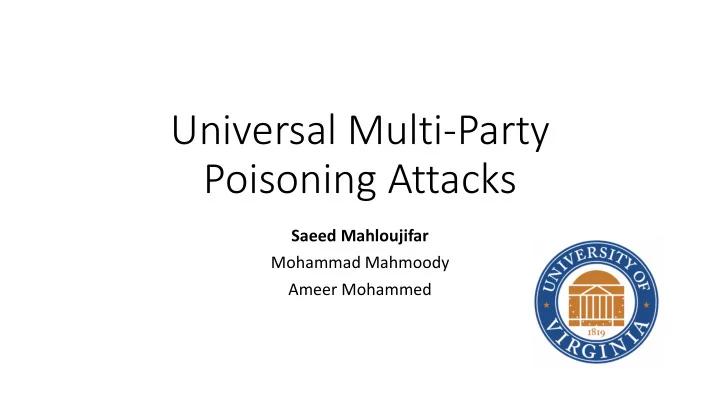

Universal Multi-Party Poisoning Attacks Saeed Mahloujifar Mohammad Mahmoody Ameer Mohammed
Multi-Party Learning Distributions Data Providers 𝐸 1 𝑄 1 Model 𝐻 𝐸 𝑜 𝑄 𝑜
Multi-Party Learning (Round j) Distributions Data Providers 𝐸 1 𝑄 1 𝐻 𝐸 𝑗 𝑄 𝑗 Model j−1 𝐸 𝑜 𝑄 𝑜
Multi-Party Learning (Round j) Distributions Data Providers 𝐸 1 𝑄 1 𝐻 𝐸 𝑗 𝑄 𝑗 Model j−1 𝐸 𝑜 𝑄 𝑜
Multi-Party Learning (Round j) Distributions Data Providers 𝐸 1 𝑄 1 𝑣 𝑘 𝑒 𝑘 𝐻 𝐸 𝑗 𝑄 𝑗 Model j−1 𝐸 𝑜 𝑄 𝑜
Multi-Party Learning (Round j) Distributions Data Providers 𝐸 1 𝑄 1 𝑣 𝑘 𝑒 𝑘 Model j 𝐻 𝐸 𝑗 𝑄 𝑗 Model j−1 𝐸 𝑜 𝑄 𝑜
Multi-Party Learning (Round j) Distributions Data Providers 𝐸 1 𝑄 1 Model j Model j Model j 𝐻 Model j 𝐸 𝑗 𝑄 𝑗 Model j Model j Model j−1 𝐸 𝑜 𝑄 𝑜
Poisoning in Multi-Party Learning Distributions Data Providers An adversary (partially) controls a 𝐸 1 𝑄 number of data providers 1 Model 𝐻 𝐸 𝑗 𝑄 𝑗 𝐸 𝑜 𝑄 𝑜
(𝑙, 𝑟) -Poisoning Attack Model 𝑙 (out of 𝑜 ) of the parties become corrupted 𝐸 𝑗 𝑄 𝑗 Each corrupted party 𝑄 𝑗 samples from a different distribution 𝑒 , ≤ 𝑟 𝐸 𝑗 𝐸 𝑗 𝑙 = 𝑜 → 𝑟 -Tampering [ACMPS14] [MM17] [MM18] 𝑟 = 1 → Static Corruption in MPC (crypto)
What is the inherent power of 𝑙, 𝑟 -poisoning adversaries against Multi-party Learning?
Main Theorem: Power of 𝑙, 𝑟 -Poisoning Let 𝐶 be a bad property of the model 𝑁 • E.g. 𝐶(𝑁) = 1 if 𝑁 misclassified an specific instance 𝑦 For any 𝑜 -party learning protocol there is a 𝑙, 𝑟 -poisoning adversary that increases Pr[𝐶] from 𝜗 → 𝜗 1− 𝑙𝑟 𝑜
Main Theorem: Power of 𝑙, 𝑟 -Poisoning Let 𝐶 be a bad property of the model 𝑁 • E.g. 𝐶(𝑁) = 1 if 𝑁 misclassified an specific instance 𝑦 For any 𝑜 -party learning protocol there is a 𝑙, 𝑟 -poisoning adversary that increases Pr[𝐶] from 𝜗 → 𝜗 1− 𝑙𝑟 𝑜 Pr[𝐶] Before attack 𝒓 𝒍 Pr[𝐶] after attack 5% 1/2 𝑜/2 11% 5% 1/2 𝑜 22% 5% 1 𝑜/2 22%
Features of Attack • Universal: provably work against any learning protocol • In contrast with: [Bagdasaryan et al 2018; Bhagoji et al. 2018] • Clean label: Only uses correct labels • Similar to: [M et al 2017; Shafahi et al 2018] • Polynomial time • Similar to: [M and Mahmoody 2019]
Ideas Behind Attack • Main Idea: Treat protocol as random process and run a biasing attack • The bad property is a function over the random process • We want to bias that function, similar to attacks in coin tossing
Ideas Behind Attack • Main Idea: Treat protocol as random process and run a biasing attack • The bad property is a function over the random process • We want to bias that function, similar to attacks in coin tossing • New biasing model: Generalized 𝑞 -Tampering.
Ideas Behind Attack • Main Idea: Treat protocol as random process and run a biasing attack • The bad property is a function over the random process • We want to bias that function, similar to attacks in coin tossing • New biasing model: Generalized 𝑞 -Tampering. Let 𝑔 ∶ 𝑉 1 , … , 𝑉 𝑜 → {0,1}
Ideas Behind Attack • Main Idea: Treat protocol as random process and run a biasing attack • The bad property is a function over the random process • We want to bias that function, similar to attacks in coin tossing • New biasing model: Generalized 𝑞 -Tampering. Let 𝑔 ∶ 𝑉 1 , … , 𝑉 𝑜 → {0,1} Input blocks 𝑣 1 , 𝑣 2 , … 𝑣 𝑜 are sampled one-by one in online way:
Ideas Behind Attack • Main Idea: Treat protocol as random process and run a biasing attack • The bad property is a function over the random process • We want to bias that function, similar to attacks in coin tossing • New biasing model: Generalized 𝑞 -Tampering. Let 𝑔 ∶ 𝑉 1 , … , 𝑉 𝑜 → {0,1} Input blocks 𝑣 1 , 𝑣 2 , … 𝑣 𝑜 are sampled one-by one in online way: 𝑉 𝑗 with marginal probability 1 − 𝑞 𝑣 𝑗 = ቊ with marginal probability 𝑞
Ideas Behind Attack • Main Idea: Treat protocol as random process and run a biasing attack • The bad property is a function over the random process • We want to bias that function, similar to attacks in coin tossing • New biasing model: Generalized 𝑞 -Tampering. Let 𝑔 ∶ 𝑉 1 , … , 𝑉 𝑜 → {0,1} Input blocks 𝑣 1 , 𝑣 2 , … 𝑣 𝑜 are sampled one-by one in online way: 𝑉 𝑗 with marginal probability 1 − 𝑞 𝑣 𝑗 = ቊ with marginal probability 𝑞 Our generalized p-tampering attack based on Ideas in coin tossing attacks [BOL89,IH14]
Summary We show Poisoning attacks against multi-party learning protocols: • Universal: Provably apply to any multi-party learning protocol • Clean label: Only uses samples with correct labels • Run in polynomial time Poster #160 • Increase the probability of any chosen bad property
Recommend
More recommend